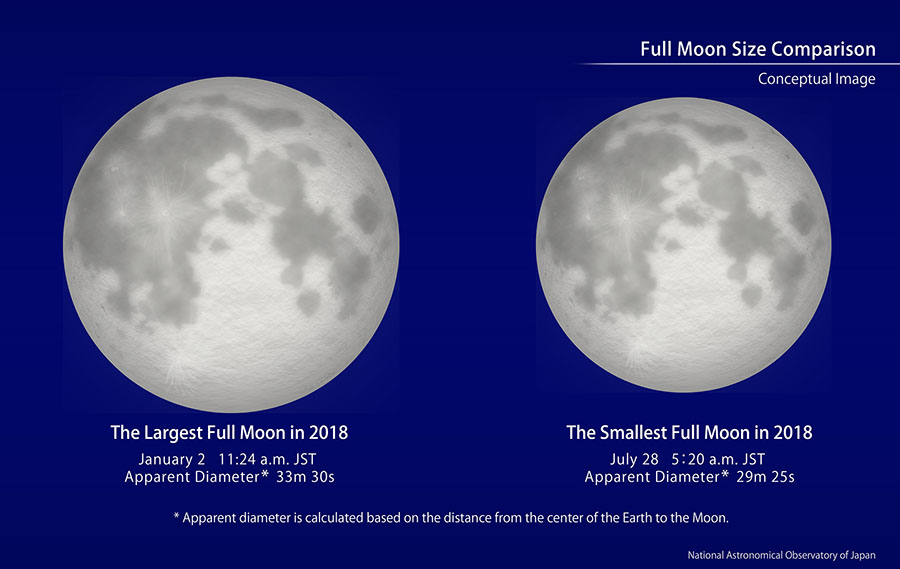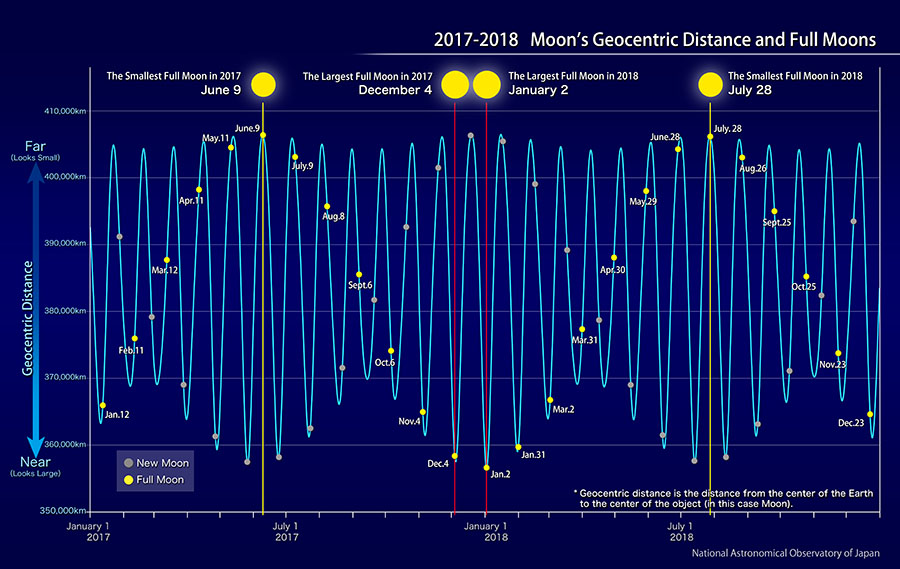Year’s Largest Full Moon (January, 2018)

Look up at the Moon, and See the Largest Full Moon of 2018!
The full moon of January 2 is the largest and closest of all the full moons (Note 1) in 2018. The Moon passes through the perigee (Note 2) at 6:49 a.m. After that, it becomes full phase at 11:24 a.m. At the time of the full moon, the geocentric distance (Note 3) is about 357,000 kilometers, and the Moon’s apparent diameter (Note 4) is 33 arcminutes 30 arcseconds.
The full moon of July 28 is the smallest and furthest in 2018. The Moon passes through the apogee (Note 5) at 2:44 p.m. on July 27 and will be at full phase at 5:20 a.m. on July 28th. The geocentric distance at the time of the full moon is about 406,000 kilometers, and the apparent diameter is about 29 minutes 25 arcseconds.
When the Moon is close to the Earth, the Moon looks big. The figure above is a diagram comparing the apparent diameter of the full moon on January 2, which is the closest Moon, and the full moon on July 28, which is the furthest of this year.
You cannot line up the real moons in the night sky to compare the sizes. But if you could line up the largest full moon and the smallest full moon in 2018 as in the figure above, you could easily see the size difference.

The Moon orbits around the Earth. The Moon’s orbit is elliptical, so the distance between the Earth and the Moon is not always the same. The orbit of the Moon changes as it is affected by the gravity of the Sun and the Earth. So, as shown in the figure above, the geocentric distances when the Moon is at the perigee and the apogee are different each time. The geocentric distance during the full moon varies from approximately 356,000 kilometers to 406,000 kilometers. The apparent diameter of the Moon is large when the Earth and Moon are close; and small when they are far from each other. The apparent diameter of the closest full moon is 14 percent larger than that of the furthest full moon. Also, the largest full moon appears 30 percent brighter than the smallest full moon. Recently, it is called a "super moon" when the Moon approaches the Earth. However, the Moon looks different every time. The Moon changes its phases and shape: the waxing crescent, the half moon, the full moon. How about gazing at the night sky and enjoying the various attractive moons?
(Note 1) “Full moon” in astronomy refers to the Moon at the moment when it is in the opposite direction from the Sun, as seen from the center of the Earth. Back
(Note 2) “Perigee” is the point where the Moon is the closest to the Earth. Back
(Note 3) “Geocentric distance” is the distance between the center of the Earth and the center of the Moon. Back
(Note 4) “Apparent diameter” is the apparent size of the celestial object. The apparent diameters shown on this page are calculated based on the geocentric distance. Back
(Note 5) “Apogee”is the point where the Moon is the farthest from the Earth. Back
Reference: Ephemeris Computation Office
With the “Sky Viewer” you can easily explore the appearance of a typical urban night sky (planets and constellations are visible). The Celestial Phenomena section of the glossary explains the planetary phenomena terms: greatest elongation, opposition, conjunction, stationary, etc.